|
Marlin was the first to chamber the .45-70
Government cartridge in a lever action rifle in their Model
1881, back when leverguns were powered for short cartridges like
the .32, .38, and .44 WCF rounds. Those were dandy little
cartridges, but had nothing like the power of the big .45-70.
Winchester had the .45-75 and .45-60 cartridges chambered in
their 1876 levergun, but there is nothing like having a gun that
chambers the current US Military cartridge to boost sales, and
the Winchester action could just not handle a cartridge as long
as the .45-70, and it would be 1886 before John Browning
designed the excellent 1886 Winchester to handle those longer
cartridges, and in a rifle of much greater strength than the
1876. The 1881 was Marlin’s first lever action rifle, and it
was a good one. Unlike Marlin’s leverguns of today, the 1881
ejected empty cases out the top. The 1881 was replaced by the
1895, which was a superior rifle, with side ejection. The .45-70
Government cartridge had been our martial cartridge since its
adoption in 1873, and would continue in that role for almost
twenty years, and as a secondary US Military cartridge for
several years thereafter. In the 1930s, that great old cartridge
was dropped from production by American rifle makers, as the
world wanted faster, flatter-shooting cartridges. However, the
.45-70 was too good of a cartridge to die, and Marlin breathed
new life into the cartridge in 1972 with the introduction of
their new Model 1895, which was their outstanding Model 336
adapted to the .45-70 cartridge. While the experts on such
things had long before declared the .45-70 cartridge obsolete,
the 1895 was an instant success. Hunters recognized the
cartridge for what it was; a superior cartridge for close range
hunting of all North American big game. The 1895 had side
ejection, a straight-gripped walnut stock, a twenty-two inch
barrel, and handled the big .45-70 cartridge well.
In 1998, Marlin introduced their Guide Gun,
which was a shortened version of the 1895. Custom gunsmiths had
been cutting down the 1895 rifles into handier brush guns, and
the Guide Gun was the factory version of those custom guns, wearing
a straight-grip checkered walnut stock, and an eighteen and
one-half inch ported barrel. I knew I had to have one, and
bought the first one that I was able to locate, driving 220
miles to pick it up. Shipping the Guide Gun to my local dealer
was not an option. I had to have it that day! The Guide Gun is a
superb rifle for close to medium range hunting of large game.
Having a total capacity of five shots, the rifle is very
quick-handling and powerful. Factory ballistics for standard
.45-70 cartridges from the major ammo makers are not too
impressive. The manufacturers are limited as to the intensity of
the loads by the many old trapdoor Springfield rifles still out
there. However, the modern Marlin is much stronger than those
old relics, and can handle ammunition that is loaded to much
higher pressures. Careful handloading of the .45-70 makes for an
impressive cartridge that is capable of taking, and has done so,
any game that walks the Earth. For those who do not handload,
ammo makers such as Garrett, Buffalo Bore, Cor-Bon, and Grizzly
Cartridge load the .45-70 to its potential in modern lever
action rifles. Bullet weights in factory-loaded cartridges run
from 300 to 540 grains, and are loaded with bullets capable of
fully penetrating a cape buffalo. Quick-expanding hollowpoints
or heavy bullets made of solid brass or copper offer outstanding
performance on small whitetails or massive pachyderms. Eighty
years after being declared obsolete, the .45-70 is now more
popular than ever, due in large part to Marlin’s introduction
of the modern Model 1895 levergun.
Now, Marlin has introduced what many consider
to be the ultimate Guide Gun, the Model 1895 SBL. The SBL takes
all of the features of the Guide Gun, and improves upon that
wonderful rifle. Like the Guide Gun, the barrel has Ballard
style rifling to handle all types of bullets well. The barrel is
still eighteen and one-half inches in length, but is not ported,
as the early Guide Guns were. It wears a full-length six-shot
magazine tube for a total capacity of seven. The SBL has a
laminated wood stock, with ample cut checkering for a positive
grip. The metal parts are mostly stainless steel, with a couple
of the smaller parts nickel plated to match. As any hunting
rifle should, the SBL has sling swivel studs for easily mounting
a sling or carry strap. I remember when it was pretty routine to
buy a new rifle, and have to drill it for sling swivel studs.
Thankfully, most good rifles now come with them already
installed. In designing the SBL, Marlin took note of the things
that many were adding to their Guide Guns to improve the
handling and sighting equipment. The SBL wears a medium-sized
lever loop, to better accommodate a large gloved hand. This is a
welcome feature to me, as my mitts are pretty big, and I find
the standard lever loop a bit crowded when wearing a glove.
Marlin has built the SBL with the XS Lever Rail in place. This
is a very popular accessory for Guide Gun owners, and I added
one to my own Guide Gun when the rail was first introduced. The
Lever Rail is a very versatile scope mount rail that allows the
easy mounting of a standard riflescope, or a scout style scope
mounted farther out on the barrel. There is also a set of the
excellent XS Ghost Ring sights in place, which consist of a
fully adjustable but rugged rear aperture and a front post with
white line up the center. They are very useful and quick at
close range. I prefer a scope for just about all of my hunting,
as a good glass enables me to see better, shoot quicker, and
place my shots more accurately. The Lever Rail allows a scout
scope to be mounted plenty far away from the shooter’s eye,
which is a welcome feature on a rifle with a lot of recoil,
which can be heavy with this SBL, depending upon the load
chosen. On the subject of recoil, the SBL wears the superb
Pachmayr Decelerator recoil pad. The is a good, soft pad which
really helps to take the pain out of shooting big bore rifles.
In fact, during all of the testing of this rifle, whether
standing or shooting from the bench, the rifle never once hurt
my shoulder, even after extensive testing during long shooting
sessions. The rifle does back up a bit with the heaviest loads,
but it is more of a big push, and never caused any shoulder
pain. The lighter loads were really easy on the shooter. Like
all modern Marlin leverguns, the SBL has a receiver-mounted
crossbolt safety, to effectively block the hammer from hitting
the firing pin. Being a long-time shooter of traditional lever
action rifles, I do not use the safety, relying upon the
half-cock hammer notch instead, but the safety is there if you
want to use it.
For accuracy testing, I mounted my Leupold
Scout Scope. This is perhaps the ideal scope for such a rifle.
It has two and one-half power magnification, which is plenty of
power for big game hunting, even in the open fields, yet is low
enough magnification for close range shooting in the woods. I
had Leupold to make a custom elevation dial for this scope,
which follows the trajectory of my favorite 405 grain load out
to 400 yards. Leupold makes these custom turrets for a very
reasonable fee. You just tell them your load, and they build the
dial. Read
more about this scope here.
The Marlin 1895 SBL was very reliable,
handling easily every handload and factory load tried. I did
encounter one problem early on, that I traced to a damaged
magazine tube. The gun arrived in a box that had been pretty
well abused in transit, but the rifle looked okay. However, it
would only accept four rounds into the mag tube. Trying to load
a fifth would jam the follower. There was no visible damage to
the tube, but checking it with a dial caliper revealed that it
had been hit on the mag tube, which resulted in an out-of-round
tube, with a tight spot about six inches from the muzzle end. A
quick call to Marlin had another tube here in two days, and
replacing the tube fixed the problem. The magazine now accepts a
full payload of six rounds, for a total loaded capacity of
seven. Whether the SBL’s six rounds is an improvement over the
Guide Gun’s four depends upon the situation. Personally, I
like the higher capacity. It gives the SBL a decided advantage
over any bolt action big game rifle, while still maintaining the
excellent handling qualities of the Guide Gun. The SBL has an
overall length of 36.5 inches, and my sample gun weighed in at 7
pounds, 6.8 ounces. With the Leupold scope in place with Warne
Quick Attach rings, it weighs 8 pounds, 3 ounces. The trigger
pull measured a crisp three and three-quarters pounds.
Since the SBL is designed for hunting large
game that bites and claws, I wanted to try out a couple of new
bullets on the market, or new to me at least. The first is the
GS Custom solid copper flatnose bullet. This bullet weighs 300
grains, and was designed specifically for lever action .45-70
rifles. It is a shortened version of their excellent flatnose
bullets that are used in large forty-five caliber cartridges,
such as the .458 Winchester and .460 Weatherby. These GS Custom
Flat Nose bullets have several driving bands which engage the
rifling, while the main body of the bullet rides the bore,
reducing pressure and allowing the bullets to be pushed faster,
safely. They are also moly coated to further reduce friction and
fouling, but uncoated bullets can be ordered, if desired. I
found them to be very accurate in the Marlin, and they exhibit
very good penetration and controlled expansion. I also used the Belt
Mountain Punch bullet in the SBL. Unlike the GS Custom
bullets, the Punch does not expand at all, instead providing
maximum penetration. It is a brass bullet with a lead core in
the rear section for added weight, is a flat nose design, and is
a fine choice when penetration matters above all else. Accuracy
is also superb with these fine bullets. Another bullet that is
new to me for the .45-70 is the North Fork Technologies bonded
core bullet. This bullet has a copper jacket bonded to a soft
lead core to provide controlled expansion without coming apart
like some bullets do. This makes the North Fork bullet less
sensitive to velocity variations, and to hold together when
fired from high velocity magnums, while still expanding at low
velocity. I also loaded the Barnes X bullet, which has proven
itself to me many times. It is a copper homogenous bullet with a
huge hollow nose that is made to expand and penetrate. Lastly, I
loaded some of my standard whitetail load, which uses the
relatively cheap and plentiful Remington 300 grain hollowpoint.
It is very accurate in my Marlins, and does a good job on light,
thin-skinned big game. With each of these bullets, my goal was
not ultimate velocity, but to achieve respectable velocity while
maintaining accuracy. None of these bullets has to be pushed to
the maximum velocity to perform well, and that is what makes
them superb hunting bullets. While I tried many different loads
for each of these, my favorite load for each bullet is listed in
the chart below. Velocities were recorded at twelve feet from
the muzzle, at an elevation of approximately 600 feet above sea
level, with an air temperature around forty degrees Fahrenheit.
Velocities are listed in feet per second. Bullet weights and
powder weights are listed in grains. All loads were very safe in
this test gun, but may not be in yours, so reduce charges a bit
to start, and always use a good loading manual and published
load data. Not load data published by me, but by a reputable
ballistics lab. I have neither a reputation nor a lab, so use
caution. All loads functioned perfectly in the SBL, and ejection
was smooth and easy, with no sticky extraction at all. Remember,
for a dangerous game rifle, function trumps velocity every time.
I load for flawless function, accuracy, and speed, in that
order. All exhibited fine accuracy, limited only by the
shooter’s ability (me) to place the bullets accurately on
target. I used the Leupold Scout scope exclusively for accuracy
testing, and accuracy was recorded using a three shot group at
fifty yards, and again at one hundred yards. All loads used
Federal 210 primers and Starline cases.
| Bullet |
Charge / Powder |
Velocity |
| Barnes 300 X |
48 H322 |
1652 |
| GS Custom 300 FN |
60 AA2015 |
2039 |
| North Fork 350 GRS |
54 AA2015 |
1841 |
| Remington 300 JHP |
46.5 AA2015 |
1516 |
| Belt Mountain 400 Punch |
48 AA2015 |
1756 |
| Buffalo Bore 300 JFN |
Factory Load |
2357 |
| Hornady 325 LEVERevolution |
Factory Load |
1787 |
As can be seen in the table, the Buffalo Bore
8E load is a real screamer. You can handload to this same level,
but I am not listing any of my loads that reach those
velocities. Buffalo Bore ammo is pressure tested in a
laboratory. My loads are not. Again, the loads that I prefer are
the ones listed above, and these bullets do not have to be
pushed to the max to work well. That is why I like them. If I
was going to Africa after the heaviest game, I would take
Buffalo Bore ammo with me, or some of my maximum handloads, but
the handloads listed above will work well for anything on this
continent. The SBL exhibited some pretty impressive velocities
from its short barrel, and the advantages of the short barrel
greatly outweigh the bit of velocity lost to a longer tube. Even
with the heavy Buffalo Bore loads, the SBL just did not thump
the shoulder at all. The muzzle did rise quickly under recoil,
but it was not painful to shoot. Accuracy was very good with
each load listed above, as again, I was seeking function and
accuracy above all else. Groups at 50 yards were typically a
cloverleaf, as shown in the picture, and one hundred yard groups
were in the one and one-quarter to two inch range with all loads
listed. It was raining steadily during the 100 yard testing, so
I was not able to get any good pictures of the groups, as the
paper targets were falling apart upon removal from the target
board. However, I was well-pleased with the accuracy of the SBL,
especially using the low powered scope. I can shoot better
groups with a target scope, but Steve Garlock was doing quite
well with the SBL at 100 yards using the Scout scope and
LEVERevolution ammunition. Steve came over one day with my
Pastor, George Hall, to do some shooting, and I was testing the
SBL at the time. It is always interesting to get a visit from
the preacher, especially when he shows up toting guns. We all
three were pretty impressed with the Marlin 1895 SBL. It is a
very good rifle with awesome power potential, American made, and
a true American tradition. There is no rifle made that is more
American than a .45-70 levergun, and the SBL is one of the best.
Check out the SBL and other Marlin products
online at www.marlinfirearms.com.
To find a Marlin dealer near you, click on
the DEALER FINDER at www.lipseys.com.
To order the SBL online, go to www.galleryofguns.com.
For a look at the entire line of Leupold
optics, go to www.leupold.com.
To order any of the premium bullets shown
here, go to www.northforkbullets.com,
www.barnesbullets.com,
www.beltmountain.com,
and for the GS Custom bullets, click on this link: http://gscustom.co.za/.
To order the Buffalo Bore ammunition, go to www.buffalobore.com.
Jeff
Quinn
NOTE: All load data posted on this
web site are for educational purposes only. Neither the author nor
GunBlast.com assume any responsibility for the use or misuse of this data.
The data indicated were arrived at using specialized equipment under
conditions not necessarily comparable to those encountered by the
potential user of this data. Always use data from respected loading
manuals and begin working up loads at least 10% below the loads indicated
in the source manual.
| For a list of dealers where you can
buy this gun, go to: |
|
To buy this gun online, go to: |
 |
|
 |
|
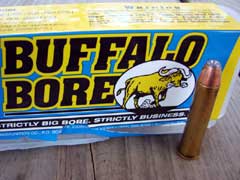
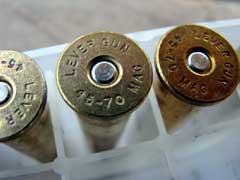
Buffalo Bore's factory loads are consistently
excellent.
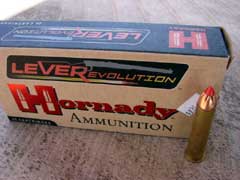
Hornady's 325-grain LEVERevolution ammo.
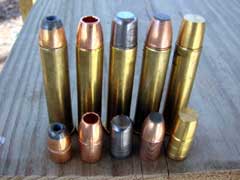
Handloads tested used (left to right):
Remington 300-grain JHP, Barnes 300-grain X bullet, GS
Custom 300-grain FN, North Fork 350-grain GRS, and Belt
Mountain 400-grain Punch Bullet.

Fifty-yard three-shot group is indicative of
the Marlin 1895 SBL's fine accuracy.

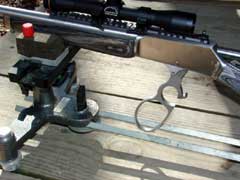
Target
Shooting, Inc. Model 1000 Rifle Rest allows easy use
of lever-action rifles.
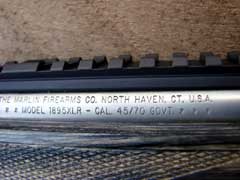
|
  
Got something to say about this article?
Want to agree (or disagree) with it? Click the following link to
go to the GUNBlast Feedback Page.
|
|
Click pictures for a larger version.

Marlin 1895 SBL .45-70 lever action rifle.
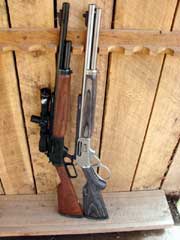
The new 1895 SBL (right) compared to an original
Guide Gun (left).
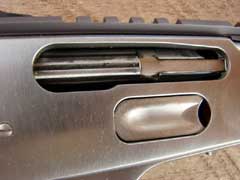

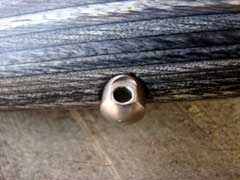
Sling studs.

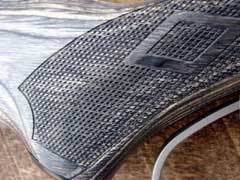
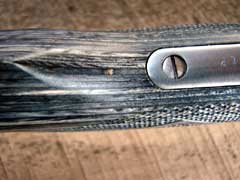

Nicely-checkered laminated stock.
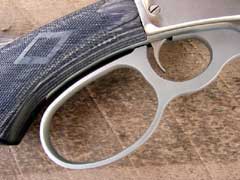
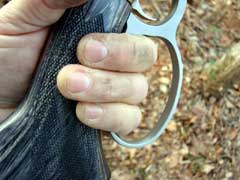
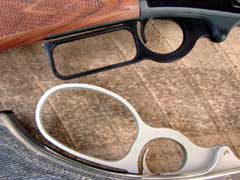
Lever loop is larger than the standard Guide Gun's.

Crossbolt safety.
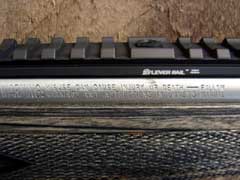


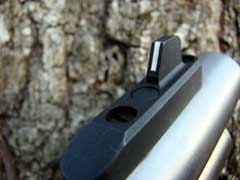
XS Lever Rail & Ghost Ring sights.

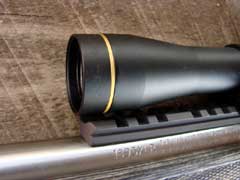
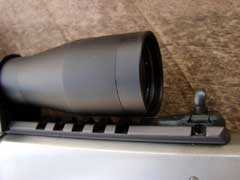

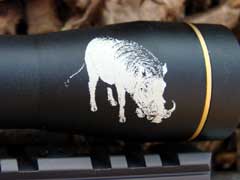
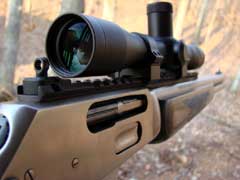

Leupold Custom Shop Scout Scope.
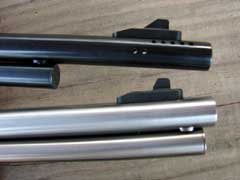

Full-length magazine tube holds two more rounds than
the Guide Gun's.
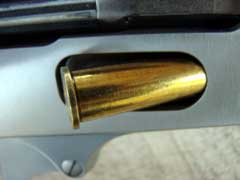
The SBL's magazine capacity is a full six rounds.
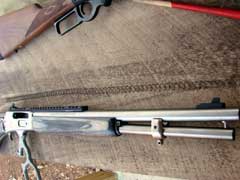
Very long magazine spring assures reliable feeding.

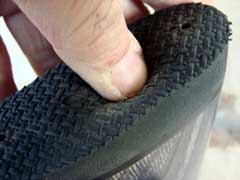
Recoil pad is very effective with even the heaviest
loads.
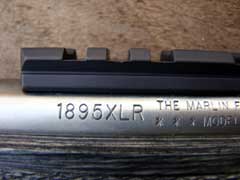
|
![]()